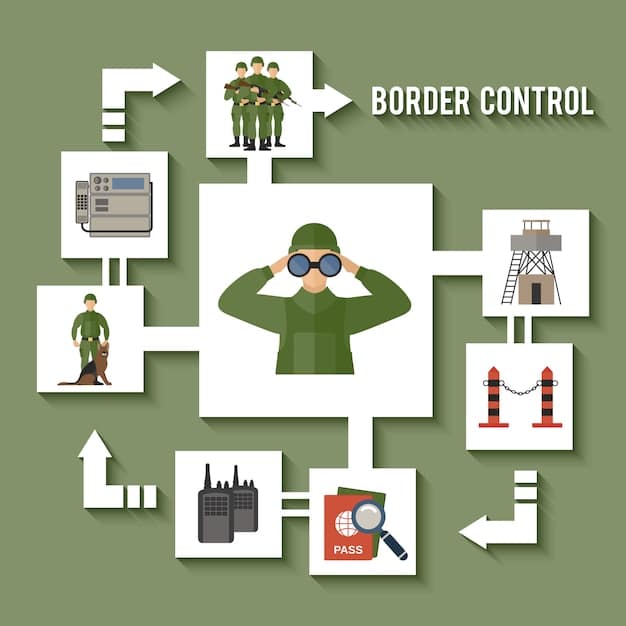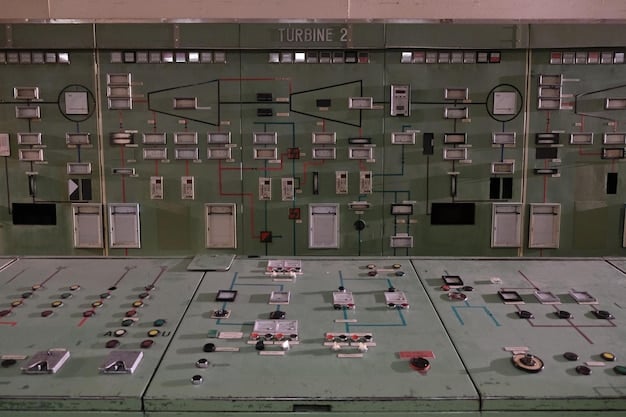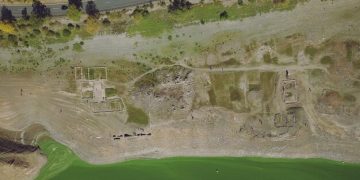How the US Military Tackles EMP Attacks: A Comprehensive Overview

The US Military is addressing the threat of Electromagnetic Pulse (EMP) attacks through a multi-faceted approach, including hardening critical infrastructure, developing advanced detection systems, and conducting rigorous training exercises to ensure operational resilience.
An Electromagnetic Pulse (EMP) attack poses a significant threat to modern society, capable of crippling electronic infrastructure and communication systems. How is the US Military Addressing the Threat of Electromagnetic Pulse (EMP) Attacks? It’s a critical question that demands a comprehensive understanding of the strategies, technologies, and protocols in place to safeguard national security.
This article delves into the proactive measures the US military is taking to mitigate the potential damage from EMP attacks, ensuring the nation’s defense capabilities remain robust and resilient in the face of this evolving threat. We will explore the layers of defense, from hardening infrastructure to advanced response strategies.
Understanding the EMP Threat Landscape
An EMP is a burst of electromagnetic energy that can disrupt or damage electronic equipment across a wide area. Several sources can cause EMPs, ranging from nuclear detonations at high altitudes to non-nuclear EMP weapons. The impact of an EMP event can be catastrophic, leading to widespread power outages, communication breakdowns, and the failure of critical systems.
The US Military recognizes the gravity of this threat and has been proactively addressing it through various strategic initiatives. A crucial first step is understanding the different types of EMPs and their potential impact on military and civilian infrastructure.
Types of EMP Threats
The US Military considers various EMP threat scenarios, each requiring different protective measures:
- High-Altitude Electromagnetic Pulse (HEMP): Generated by a nuclear explosion at a high altitude, affecting a vast geographical area.
- E1 Pulse: A fast, high-frequency pulse that can damage unprotected electronic devices.
- E2 Pulse: Similar to lightning, posing a threat to electrical infrastructure and grounding systems.
- E3 Pulse: A slow pulse that can induce currents in long conductors, such as power lines.

Understanding these distinct EMP characteristics is paramount for developing effective countermeasures and prioritizing defense efforts. The US military continuously assesses these threats to adapt and refine its defense strategies.
In conclusion, the threat landscape surrounding EMP attacks is complex and varied, necessitating a comprehensive and adaptive defense strategy. The US military’s commitment to understanding and mitigating these threats is evident in its continuous efforts to refine and implement effective countermeasures. How is the US Military Addressing the Threat of Electromagnetic Pulse (EMP) Attacks? By staying vigilant and proactive, the US military aims to safeguard national security against this evolving threat.
Hardening Military Infrastructure Against EMPs
One of the primary methods the US Military employs to counter EMP threats is hardening its infrastructure. This involves protecting critical facilities, communication systems, and equipment from the damaging effects of electromagnetic energy.
Hardening measures range from physical shielding to advanced electronic safeguards. By fortifying these assets, the military aims to ensure operational continuity even in the face of a significant EMP event.
Specific Hardening Techniques
Several techniques are used to harden military infrastructure against EMPs:
- Faraday Cages: Enclosing sensitive equipment within conductive enclosures to block electromagnetic fields.
- Shielded Cables and Connectors: Utilizing cables and connectors designed to minimize electromagnetic interference.
- Surge Arresters: Installing surge protection devices to divert excess voltage caused by EMPs.
- Fiber Optic Communication: Replacing copper cables with fiber optics, which are immune to electromagnetic pulses.
These hardening measures are not limited to new constructions. Retrofitting existing facilities is also a priority to enhance their resilience. The US Military invests significantly in upgrading its older infrastructure to meet modern EMP protection standards.

Moreover, the US Military conducts regular assessments to identify vulnerabilities and implement necessary upgrades. This proactive approach ensures that hardening measures remain effective against evolving EMP threats. The integration of advanced technologies, such as AI-driven monitoring systems, further enhances the effectiveness of these defenses.
In conclusion, hardening military infrastructure is a critical component of the US Military’s EMP defense strategy. By employing a range of physical and electronic safeguards, the military aims to protect its assets and maintain operational readiness. How is the US Military Addressing the Threat of Electromagnetic Pulse (EMP) Attacks? Through continuous assessment, upgrades, and the integration of advanced technologies, the military ensures that its hardening measures remain robust and effective.
Advanced EMP Detection and Warning Systems
In addition to hardening its infrastructure, the US military is investing in advanced EMP detection and warning systems. Early detection is critical for initiating defensive measures and mitigating the impact of an EMP attack.
These systems utilize a network of sensors, satellites, and ground-based stations to monitor electromagnetic activity and provide timely alerts. By rapidly identifying and characterizing EMP events, the military can activate response protocols and protect critical assets.
Key Components of EMP Detection Systems
The US military employs several sophisticated components for EMP detection:
- Satellite-Based Sensors: Monitoring space for potential nuclear detonations and EMP events.
- Ground-Based Sensors: Detecting electromagnetic disturbances and characterizing their source.
- Ionospheric Monitoring Stations: Measuring changes in the ionosphere caused by EMPs.
- Advanced Signal Processing: Analyzing sensor data to distinguish between natural and artificial EMP events.
These detection systems are designed to work in tandem, providing a comprehensive and reliable early warning capability. The data collected from these sensors is processed using advanced algorithms to provide actionable intelligence to military commanders.
Furthermore, the US Military collaborates with international partners to enhance its EMP detection capabilities. Sharing data and resources improves global awareness and bolsters collective defense against EMP threats. These collaborations extend to joint research and development efforts, ensuring that EMP detection technologies remain at the cutting edge.
In conclusion, advanced EMP detection and warning systems are essential for providing early alerts and enabling timely defensive measures. By leveraging a network of sensors, satellites, and ground-based stations, the US military can rapidly identify and characterize EMP events. How is the US Military Addressing the Threat of Electromagnetic Pulse (EMP) Attacks? Through continuous investment in these advanced systems and collaboration with international partners, the military ensures it remains vigilant and prepared to respond to EMP threats.
Developing EMP-Resistant Technologies
Another critical aspect of the US Military’s EMP defense strategy is the development of EMP-resistant technologies. This involves designing and manufacturing electronic devices and systems that can withstand the effects of electromagnetic pulses.
These technologies span a wide range of applications, from communication equipment to weapons systems. By incorporating EMP-resistant components and designs, the military aims to ensure that its equipment remains operational during and after an EMP event.
Strategies for Developing EMP-Resistant Technologies
The development of EMP-resistant technologies involves several key strategies:
- Component Shielding: Encasing sensitive electronic components within conductive shields to protect them from electromagnetic fields.
- Circuit Design: Optimizing circuit layouts to minimize EMP-induced currents and voltages.
- Material Selection: Choosing materials that are less susceptible to electromagnetic interference.
- Redundancy and Backup Systems: Incorporating redundant systems and backup power supplies to ensure operational continuity.
The US Military works closely with defense contractors and research institutions to develop and test EMP-resistant technologies. Rigorous testing is conducted to ensure that these technologies meet stringent performance requirements.
Moreover, the military promotes the standardization of EMP-resistant technologies to facilitate interoperability and reduce costs. By adopting common standards, the military ensures that different systems can work together seamlessly, even after an EMP event. This standardization also encourages broader adoption of EMP-resistant technologies across both military and civilian sectors.
In conclusion, the development of EMP-resistant technologies is a crucial element of the US Military’s EMP defense strategy. By incorporating EMP-resistant components and designs into its equipment, the military aims to ensure operational continuity during and after an EMP event. How is the US Military Addressing the Threat of Electromagnetic Pulse (EMP) Attacks? Through collaboration with defense contractors and research institutions, the military continues to innovate and improve EMP-resistant technologies.
Training and Response Protocols for EMP Attacks
Effective training and well-defined response protocols are essential for mitigating the impact of EMP attacks. The US Military conducts regular training exercises to prepare personnel for responding to EMP events and other disruptions.
These exercises simulate various EMP scenarios, allowing military personnel to practice response procedures and adapt to dynamic situations. By preparing for these events, the military aims to minimize the damage and ensure the swift recovery of critical systems.
Key Elements of EMP Training and Response
EMP training and response protocols encompass several key elements:
- Emergency Response Procedures: Implementing protocols for quickly securing critical infrastructure and restoring essential services.
- Communication Protocols: Establishing redundant communication channels to maintain situational awareness.
- Damage Assessment and Repair: Training personnel to assess damage and implement repair strategies.
- Coordination with Civilian Authorities: Establishing clear lines of communication and coordination with civilian agencies.
The US Military also conducts joint exercises with civilian authorities to improve coordination and preparedness. These exercises involve scenarios ranging from power grid failures to widespread communication disruptions. The goal is to ensure that military and civilian agencies can work together effectively in the event of an EMP attack.
Furthermore, the military invests in public awareness campaigns to educate citizens about EMP threats and preparedness measures. By increasing public awareness, the military aims to build a more resilient society capable of withstanding and recovering from EMP events.
In conclusion, training and response protocols are critical for mitigating the impact of EMP attacks. By conducting regular training exercises and establishing clear lines of communication, the US Military prepares its personnel and collaborates with civilian authorities to ensure a coordinated response. How is the US Military Addressing the Threat of Electromagnetic Pulse (EMP) Attacks? Through ongoing training, joint exercises, and public awareness campaigns, the military aims to enhance national resilience and minimize the damage from EMP events.
| Key Point | Brief Description |
|---|---|
| 🛡️ Infrastructure Hardening | Protecting critical facilities and communication systems. |
| 🚨 Detection Systems | Using sensors and satellites for early EMP detection. |
| ⚙️ EMP-Resistant Tech | Developing devices that withstand EMP effects. |
| 훈련 Response Training | Preparing personnel with EMP response protocols. |
Frequently Asked Questions
An Electromagnetic Pulse (EMP) is a burst of electromagnetic energy that can disrupt or damage electronic equipment over a wide area. It can be caused by natural phenomena or, more concerningly, by a nuclear detonation or a specialized weapon.
EMP poses a major threat to the US Military because of the military’s reliance on electronic and communication systems. An EMP attack could cripple these systems, impacting defense capabilities and national security.
How is the US Military Addressing the Threat of Electromagnetic Pulse (EMP) Attacks? The Military is preparing through hardening infrastructure, developing advanced detection systems, creating EMP-resistant technologies, and conducting training exercises to prepare personnel for EMP attacks.
Measures to protect civilian infrastructure include strengthening the power grid, securing critical communication networks, and increasing public awareness. These efforts are undertaken in coordination with military initiatives.
Yes, individuals can prepare by having backup communication devices, stocking non-electric tools and supplies, and learning about EMP preparedness. Public awareness campaigns provide vital information for individual readiness.
Conclusion
Addressing the threat of EMP attacks is a multifaceted and ongoing endeavor for the US Military. Through infrastructure hardening, advanced detection systems, technology development, and comprehensive training, the military is actively working to mitigate the potential damage and ensure national security. How is the US Military Addressing the Threat of Electromagnetic Pulse (EMP) Attacks?
The continuous evolution of EMP defense strategies reflects the commitment to staying ahead of emerging threats and safeguarding the nation’s critical infrastructure and defense capabilities. This proactive approach enables a more resilient and secure future for the United States.





